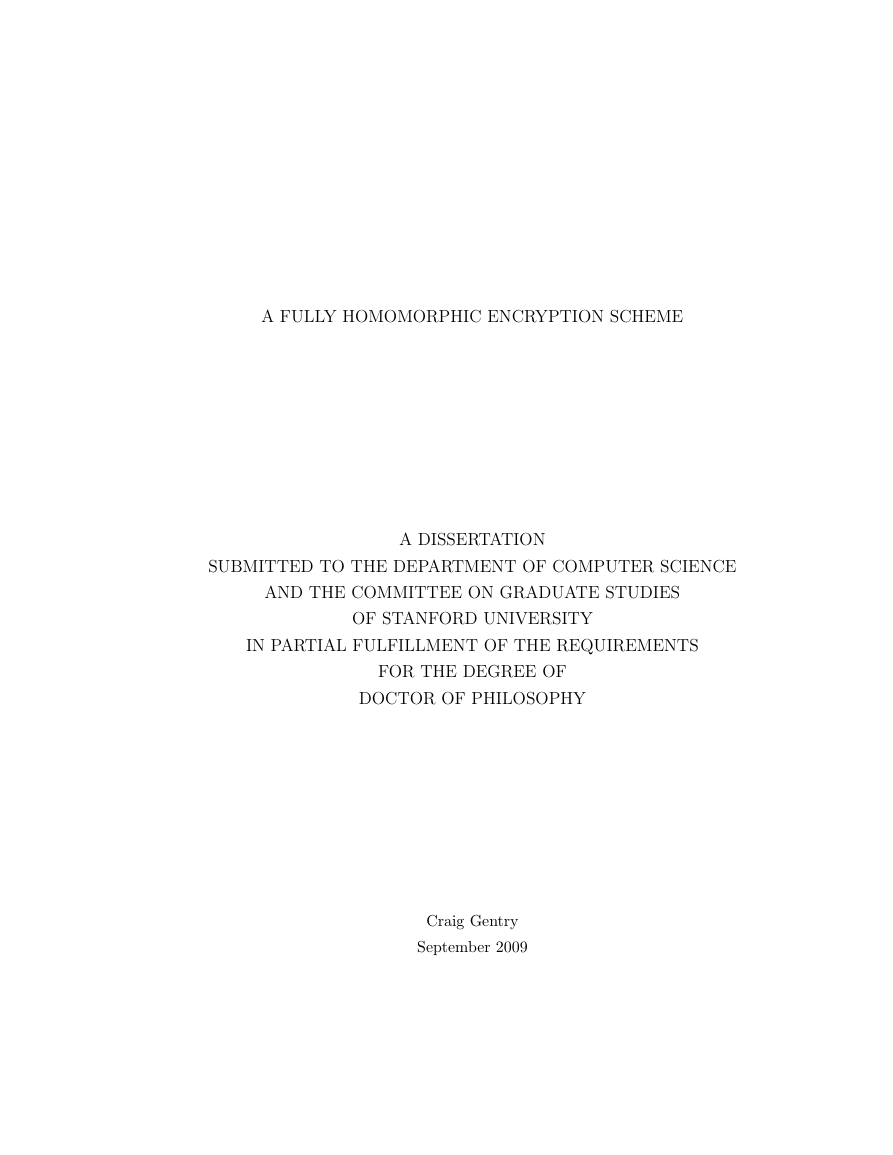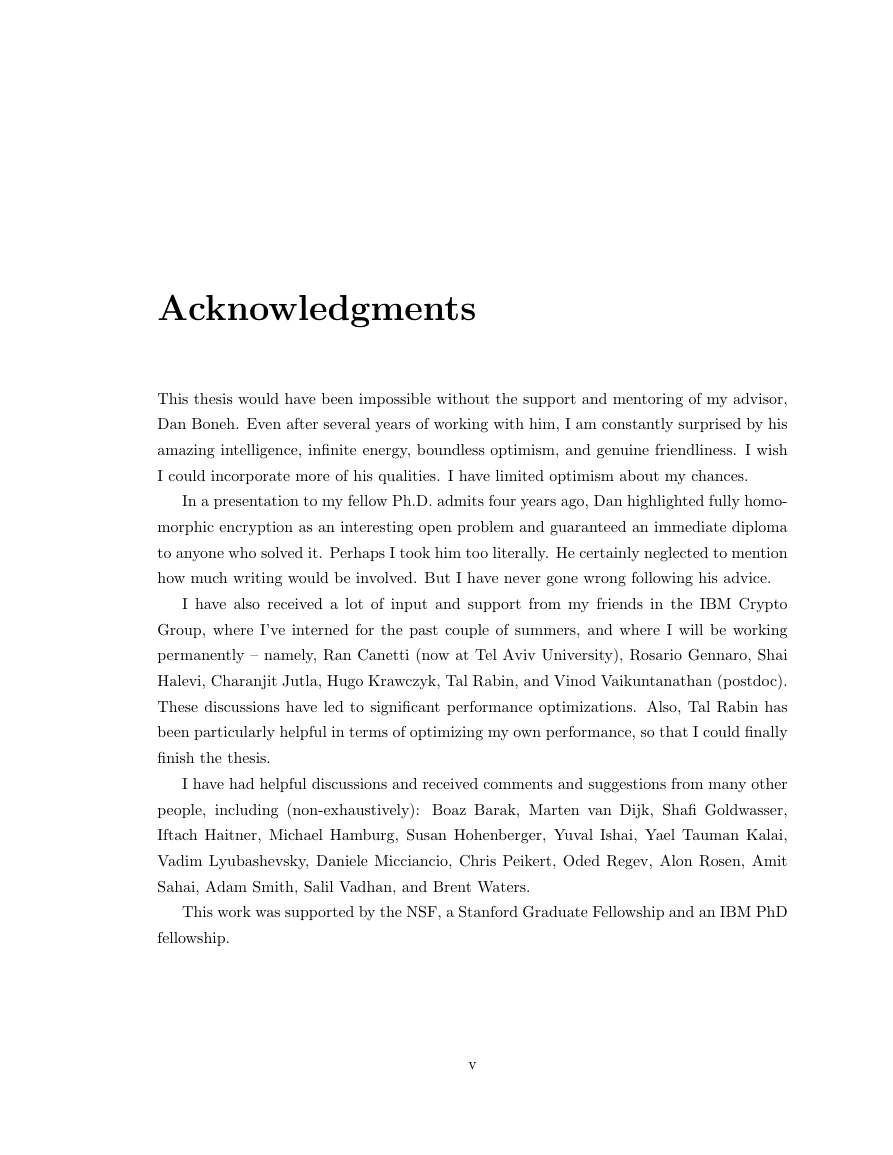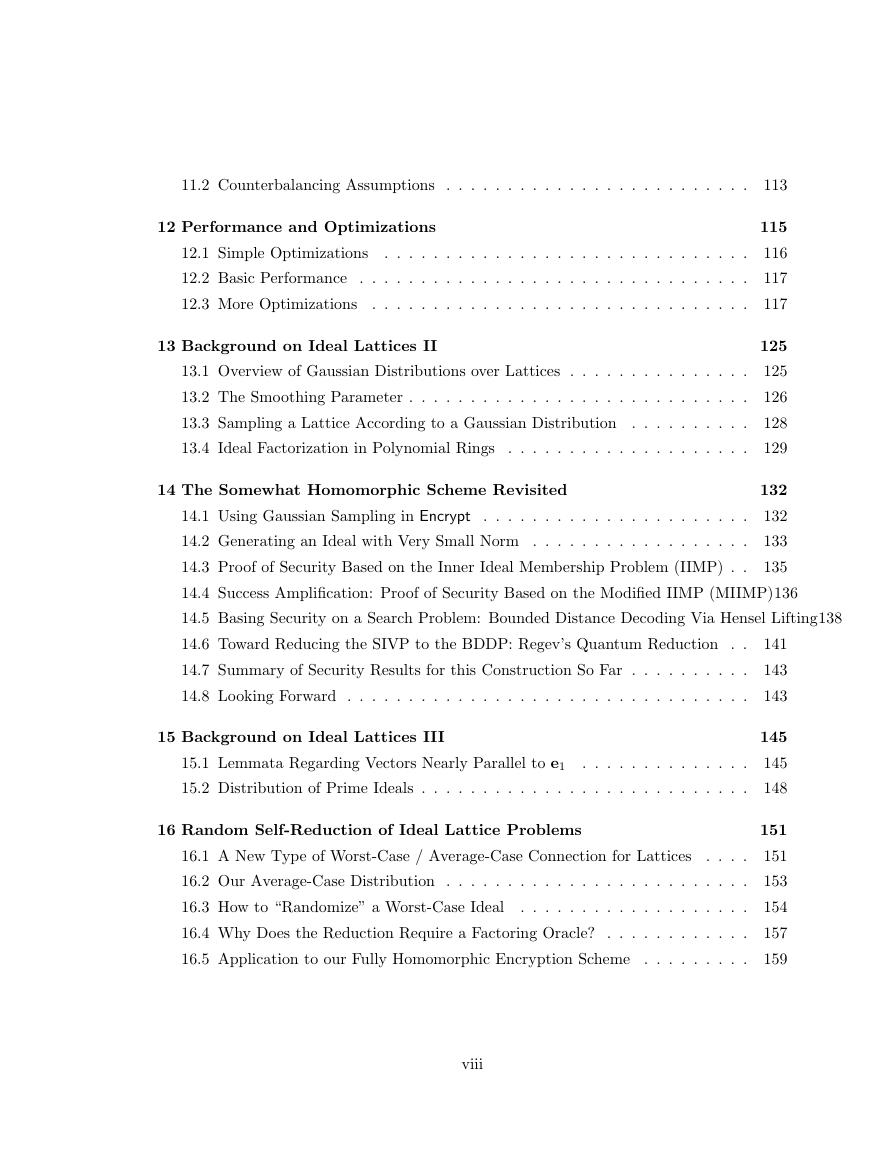A FULLY HOMOMORPHIC ENCRYPTION SCHEME
A DISSERTATION
SUBMITTED TO THE DEPARTMENT OF COMPUTER SCIENCE
AND THE COMMITTEE ON GRADUATE STUDIES
OF STANFORD UNIVERSITY
IN PARTIAL FULFILLMENT OF THE REQUIREMENTS
FOR THE DEGREE OF
DOCTOR OF PHILOSOPHY
Craig Gentry
September 2009
�
c Copyright by Craig Gentry 2009
All Rights Reserved
ii
�
I certify that I have read this dissertation and that, in my opinion, it is fully
adequate in scope and quality as a dissertation for the degree of Doctor of
Philosophy.
(Dan Boneh) Principal Adviser
I certify that I have read this dissertation and that, in my opinion, it is fully
adequate in scope and quality as a dissertation for the degree of Doctor of
Philosophy.
(John Mitchell)
I certify that I have read this dissertation and that, in my opinion, it is fully
adequate in scope and quality as a dissertation for the degree of Doctor of
Philosophy.
(Serge Plotkin)
Approved for the University Committee on Graduate Studies.
iii
�
Abstract
We propose the first fully homomorphic encryption scheme, solving a central open problem
in cryptography. Such a scheme allows one to compute arbitrary functions over encrypted
data without the decryption key – i.e., given encryptions E(m1), . . . , E(mt) of m1, . . . , mt,
one can efficiently compute a compact ciphertext that encrypts f(m1, . . . , mt) for any effi-
ciently computable function f. This problem was posed by Rivest et al. in 1978.
Fully homomorphic encryption has numerous applications. For example, it enables
private queries to a search engine – the user submits an encrypted query and the search
engine computes a succinct encrypted answer without ever looking at the query in the
clear.
It also enables searching on encrypted data – a user stores encrypted files on a
remote file server and can later have the server retrieve only files that (when decrypted)
satisfy some boolean constraint, even though the server cannot decrypt the files on its own.
More broadly, fully homomorphic encryption improves the efficiency of secure multiparty
computation.
Our construction begins with a somewhat homomorphic “boostrappable” encryption
scheme that works when the function f is the scheme’s own decryption function. We then
show how, through recursive self-embedding, bootstrappable encryption gives fully homo-
morphic encryption. The construction makes use of hard problems on ideal lattices.
iv
�
Acknowledgments
This thesis would have been impossible without the support and mentoring of my advisor,
Dan Boneh. Even after several years of working with him, I am constantly surprised by his
amazing intelligence, infinite energy, boundless optimism, and genuine friendliness. I wish
I could incorporate more of his qualities. I have limited optimism about my chances.
In a presentation to my fellow Ph.D. admits four years ago, Dan highlighted fully homo-
morphic encryption as an interesting open problem and guaranteed an immediate diploma
to anyone who solved it. Perhaps I took him too literally. He certainly neglected to mention
how much writing would be involved. But I have never gone wrong following his advice.
I have also received a lot of input and support from my friends in the IBM Crypto
Group, where I’ve interned for the past couple of summers, and where I will be working
permanently – namely, Ran Canetti (now at Tel Aviv University), Rosario Gennaro, Shai
Halevi, Charanjit Jutla, Hugo Krawczyk, Tal Rabin, and Vinod Vaikuntanathan (postdoc).
These discussions have led to significant performance optimizations. Also, Tal Rabin has
been particularly helpful in terms of optimizing my own performance, so that I could finally
finish the thesis.
I have had helpful discussions and received comments and suggestions from many other
people, including (non-exhaustively): Boaz Barak, Marten van Dijk, Shafi Goldwasser,
Iftach Haitner, Michael Hamburg, Susan Hohenberger, Yuval Ishai, Yael Tauman Kalai,
Vadim Lyubashevsky, Daniele Micciancio, Chris Peikert, Oded Regev, Alon Rosen, Amit
Sahai, Adam Smith, Salil Vadhan, and Brent Waters.
This work was supported by the NSF, a Stanford Graduate Fellowship and an IBM PhD
fellowship.
v
�
Contents
Abstract
Acknowledgments
1 Introduction
1.1 A Very Brief and Informal Overview of Our Construction . . . . . . . . . .
1.2 What is Fully Homomorphic Encryption? . . . . . . . . . . . . . . . . . . .
1.3 Bootstrapping a Scheme that Can Evaluate its Own Decryption Circuit . .
1.4
Ideal Lattices: Ideally Suited to Construct Bootstrappable Encryption . . .
1.5 Squashing the Decryption Circuit: The Encrypter Starts Decryption! . . . .
1.6 Security . . . . . . . . . . . . . . . . . . . . . . . . . . . . . . . . . . . . . .
1.7 Performance . . . . . . . . . . . . . . . . . . . . . . . . . . . . . . . . . . . .
1.8 Applications . . . . . . . . . . . . . . . . . . . . . . . . . . . . . . . . . . . .
2 Definitions related to Homomorphic Encryption
2.1 Basic Definitions . . . . . . . . . . . . . . . . . . . . . . . . . . . . . . . . .
2.2 Computational Security Definitions . . . . . . . . . . . . . . . . . . . . . . .
3 Previous Homomorphic Encryption Schemes
4 Bootstrappable Encryption
iv
v
1
2
5
7
10
15
18
20
21
27
27
31
34
43
4.1 Leveled Fully Homomorphic Encryption from Bootstrappable Encryption, Generically 43
4.2 Correctness, Computational Complexity and Security of the Generic Construction 48
4.3 Fully Homomorphic Encryption from KDM-Secure Bootstrappable Encryption 51
4.4 Fully Homomorphic Encryption from Bootstrappable Encryption in the Random Oracle Model 53
vi
�
5 An Abstract Scheme Based on the Ideal Coset Problem
5.1 The Ideal Coset Problem . . . . . . . . . . . . . . . . . . . . . . . . . . . .
5.2 An Abstract Scheme . . . . . . . . . . . . . . . . . . . . . . . . . . . . . . .
5.3 Security of the Abstract Scheme
. . . . . . . . . . . . . . . . . . . . . . . .
6 Background on Ideal Lattices I: The Basics
6.1 Basic Background on Lattices . . . . . . . . . . . . . . . . . . . . . . . . . .
6.2 Basic Background on Ideal Lattices . . . . . . . . . . . . . . . . . . . . . . .
6.3 Probability Background . . . . . . . . . . . . . . . . . . . . . . . . . . . . .
57
58
59
62
63
63
65
68
7 A Somewhat Homomorphic Encryption Scheme
7.1 Why Lattices?
. . . . . . . . . . . . . . . . . . . . . . . . . . . . . . . . . .
7.2 Why Ideal Lattices? . . . . . . . . . . . . . . . . . . . . . . . . . . . . . . .
7.3 A Geometric Approach to Maximizing the Circuit Depth that Can Be Evaluated 70
Instantiating the Ring: The Geometry of Polynomial Rings . . . . . . . . .
7.4
Instantiating Encrypt and Minimizing rEnc . . . . . . . . . . . . . . . . . . .
7.5
7.6
Instantiating Decrypt and Maximizing rDec . . . . . . . . . . . . . . . . . . .
7.7 Security of the Concrete Scheme . . . . . . . . . . . . . . . . . . . . . . . .
7.8 How Useful is the Somewhat Homomorphic Scheme By Itself? . . . . . . . .
72
75
75
77
79
69
69
70
81
82
85
86
8 Tweaks to the Somewhat Homomorphic Scheme
8.1 On the Relationship between the Dual and the Inverse of an Ideal Lattice .
8.2 Transference Lemmas for Ideal Lattices
. . . . . . . . . . . . . . . . . . . .
8.3 Tweaking the Decryption Equation . . . . . . . . . . . . . . . . . . . . . . .
8.4 A Tweak to Reduce the Circuit Complexity of the Rounding Step in Decryption 88
9 Decryption Complexity of the Tweaked Scheme
90
10 Squashing the Decryption Circuit
98
98
10.1 A Generic Description of the Transformation . . . . . . . . . . . . . . . . .
100
10.2 How to Squash, Concretely . . . . . . . . . . . . . . . . . . . . . . . . . . .
10.3 Bootstrapping Achieved: The Decryption Circuit for the Transformed System 102
11 Security
11.1 Regarding the Hint Given in Our “Squashing” Transformation . . . . . . .
104
104
vii
�
11.2 Counterbalancing Assumptions . . . . . . . . . . . . . . . . . . . . . . . . .
113
12 Performance and Optimizations
. . . . . . . . . . . . . . . . . . . . . . . . . . . . . .
12.1 Simple Optimizations
12.2 Basic Performance . . . . . . . . . . . . . . . . . . . . . . . . . . . . . . . .
12.3 More Optimizations
. . . . . . . . . . . . . . . . . . . . . . . . . . . . . . .
13 Background on Ideal Lattices II
13.1 Overview of Gaussian Distributions over Lattices . . . . . . . . . . . . . . .
13.2 The Smoothing Parameter . . . . . . . . . . . . . . . . . . . . . . . . . . . .
13.3 Sampling a Lattice According to a Gaussian Distribution . . . . . . . . . .
13.4 Ideal Factorization in Polynomial Rings
. . . . . . . . . . . . . . . . . . . .
115
116
117
117
125
125
126
128
129
14 The Somewhat Homomorphic Scheme Revisited
14.1 Using Gaussian Sampling in Encrypt
. . . . . . . . . . . . . . . . . . . . . .
14.2 Generating an Ideal with Very Small Norm . . . . . . . . . . . . . . . . . .
14.3 Proof of Security Based on the Inner Ideal Membership Problem (IIMP) . .
14.4 Success Amplification: Proof of Security Based on the Modified IIMP (MIIMP)136
14.5 Basing Security on a Search Problem: Bounded Distance Decoding Via Hensel Lifting138
14.6 Toward Reducing the SIVP to the BDDP: Regev’s Quantum Reduction . .
14.7 Summary of Security Results for this Construction So Far . . . . . . . . . .
14.8 Looking Forward . . . . . . . . . . . . . . . . . . . . . . . . . . . . . . . . .
141
143
143
132
132
133
135
15 Background on Ideal Lattices III
. . . . . . . . . . . . . .
15.1 Lemmata Regarding Vectors Nearly Parallel to e1
15.2 Distribution of Prime Ideals . . . . . . . . . . . . . . . . . . . . . . . . . . .
16 Random Self-Reduction of Ideal Lattice Problems
16.1 A New Type of Worst-Case / Average-Case Connection for Lattices
. . . .
16.2 Our Average-Case Distribution . . . . . . . . . . . . . . . . . . . . . . . . .
16.3 How to “Randomize” a Worst-Case Ideal
. . . . . . . . . . . . . . . . . . .
16.4 Why Does the Reduction Require a Factoring Oracle? . . . . . . . . . . . .
16.5 Application to our Fully Homomorphic Encryption Scheme . . . . . . . . .
145
145
148
151
151
153
154
157
159
viii
�
















 2023年江西萍乡中考道德与法治真题及答案.doc
2023年江西萍乡中考道德与法治真题及答案.doc 2012年重庆南川中考生物真题及答案.doc
2012年重庆南川中考生物真题及答案.doc 2013年江西师范大学地理学综合及文艺理论基础考研真题.doc
2013年江西师范大学地理学综合及文艺理论基础考研真题.doc 2020年四川甘孜小升初语文真题及答案I卷.doc
2020年四川甘孜小升初语文真题及答案I卷.doc 2020年注册岩土工程师专业基础考试真题及答案.doc
2020年注册岩土工程师专业基础考试真题及答案.doc 2023-2024学年福建省厦门市九年级上学期数学月考试题及答案.doc
2023-2024学年福建省厦门市九年级上学期数学月考试题及答案.doc 2021-2022学年辽宁省沈阳市大东区九年级上学期语文期末试题及答案.doc
2021-2022学年辽宁省沈阳市大东区九年级上学期语文期末试题及答案.doc 2022-2023学年北京东城区初三第一学期物理期末试卷及答案.doc
2022-2023学年北京东城区初三第一学期物理期末试卷及答案.doc 2018上半年江西教师资格初中地理学科知识与教学能力真题及答案.doc
2018上半年江西教师资格初中地理学科知识与教学能力真题及答案.doc 2012年河北国家公务员申论考试真题及答案-省级.doc
2012年河北国家公务员申论考试真题及答案-省级.doc 2020-2021学年江苏省扬州市江都区邵樊片九年级上学期数学第一次质量检测试题及答案.doc
2020-2021学年江苏省扬州市江都区邵樊片九年级上学期数学第一次质量检测试题及答案.doc 2022下半年黑龙江教师资格证中学综合素质真题及答案.doc
2022下半年黑龙江教师资格证中学综合素质真题及答案.doc